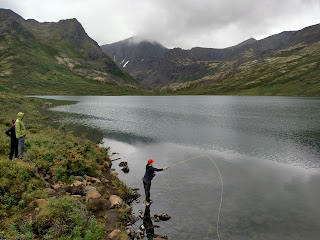Symphony Lake
There are probably two dozen places to fish salmon streams roadside within an hour’s drive of Anchorage. Or, you could hike all day in order to catch grayling so small that, if you were to eat them at all, it would definitely make sense to swallow them whole.
Don’t walk out to Symphony Lake to fill your freezer. Do visit Symphony for transcendent alpine vistas and the raw, childish pleasure of catching grayling, which must be the silliest fish in Alaska. Last time I fished Symphony Lake, there was a hatch of small, dark bugs. Thousands of them were landing on the water, a few of which were devoured by grayling rising to the surface.
There is nothing that excites a fisherman more than arriving and seeing dozens of fish rising. After watching the fish rise for a minute, I rigged up a small, dark dry fly in an attempt to match the hatch and imitate the appearance of whatever bug was in the midst of prodigious procreation. Although grayling have a reputation for eating just about anything, they were not interested in my small dry fly that so precisely replicated the hatching bugs. Maybe they were tired of eating the same thing (I would be). I switched to a streamer, stripping it through the water to imitate a fish swimming. Streamers hae often lured in grayling on other streams and lakes in the state. Once again, no success.
At that point, the fish were still rising, often just a few feet in front of me, flaunting my ineffectiveness. Some neighbors of ours had just arrived at the lake as well, and while rigging their rods noted that usually grayling will strike at anything...except, apparently, what I was using.
Fortunately, grayling are not deterred by the thrashing of fly lines in the water, by humans walking around to untangle flies from the brush, or other commotion. For my third fly, I used a bizarre, clown-colored dry fly that is unlike any living creature I’ve seen in Alaska. It is striped yellow and black, but is not a bee imitation--instead, there is an inexplicable red nose (or butt) that pokes off one end of the fly.
Tired of eating real, small, black bugs, the grayling loved this fly. One after another attempted to eat it, allowing everyone in our group to catch the fish. The hard part was taking a picture of them in a manner that didn’t look like we’d just caught something that escaped from a bait tank. After growing bored with the dry fly, I switched lures again. Out of curiosity, I tied on a tiny rooster tail with a spoon, and stripped it back in after casting out in the water. Compelled by the irresistible motion of a tiny spoon, and deluded by the tantalizing swaying of the rooster tail streamer, grayling hit the spoon like they couldn’t wait to consume metal.
The only problem with catching lots of little grayling is that it presents existential questions that are beyond my mental capacity to ponder, much less solve. Such as: Why would I spend so much time trying to catch five inch long fish instead of just looking around at this incredible landscape? Am I really communing, spiritually, with this finned creature that now has a giant hole in its mouth? Actually, I am quite capable of answering that philosophical question: Yes. I love fish that love to eat metal. I will walk for several hours to spend time with them, as long as it’s in the most beautiful place on earth. Grayling are tired of eating the same little black bugs, and I will give them an alternative. It is a symbiotic relationship, in which the fish’s contribution to my spiritual health far outweighs its negligible weight, its utter inability to contribute to an impressive fishing photograph, and (this is what I tell myself), the holes in the fishes’ mouths.
Here’s to the Symphony grayling: Little lake spirits that compel fishermen to come from miles away, even though the fish will never provide more than a supper.



Comments
Post a Comment